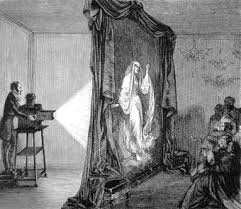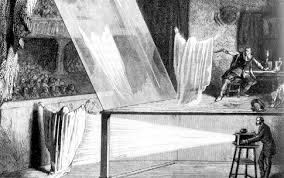Yesterday I was watching the new episodes of Criminal Minds, one of my favourite tv series because of the psychological aspects and phylosophical explanations that they give to the situations. My favourite character Spencer Reid, one of the profilers, talked about "Phantasmagorias" and immediately wrote down a note to make an article about this in Gothic Divine Magazine because I'm sure you would be very interested in this too. :)
Phantasmagoria (also known as fantasmagoria) was a form of theatre which used a modified magic lantern to project frightening images such as skeletons, demons, and ghosts onto walls, smoke, or semi-transparent screens, frequently using rear projection. The projector was mobile, allowing the projected image to move and change size on the screen, and multiple projecting devices allowed for quick switching of different images. Invented in France in the late 18th century, it gained popularity through most of Europe (especially England) throughout the 19th century.Paul Philidor created what may have been the first true phantasmagoria show in 1789, a combination of séance parlor tricks and projection effects, his show saw success in Berlin, Vienna, and revolution-era Paris in 1793. These last decades of the 18th century saw the rise of the age of Romanticism. This movement had elements of the bizarre and irrational, and included the rise of the Gothic novel which often centered on mystery and the psychology of its characters. The popular interest in such topics explained the rise and, more specifically, the success of phantasmagoria for the productions to come.

The magic lantern has been credited to both Athanasius Kircher and Christiaan Huygens in the early to mid-17th century, respectively. Kircher’s device consisted of a lantern with a candle and concave mirror inside. A tube was fitted into the side of the lantern and held convex lenses at either end. Near the center of the tube, a glass slide of the image to be projected was held. Huygens’ magic lantern has been described as the predecessor of today’s slide projector and the forerunner of the motion picture projector. Images were hand painted onto the glass slide until the mid-19th century when photographic slides were employed. Though Huygens’ magic lantern was often used for amusement by projecting quaint and pastoral imagery, phantoms, devils, and other macabre objects were also sometimes projected, thus giving rise to phantasmagoria.In the mid-18th century, in Leipzig, Germany, a coffee shop owner named Johann Georg Schröpfer began offering séances in a converted billiards room which became so popular that by the 1760s he had transformed himself into a full-time showman, using elaborate effects including projections of ghosts to create a convincing spirit experience. In 1774, he committed suicide, apparently a victim of delusions of his own apparitions.

(the Pepper's Ghost effect, still used nowadays to create illusions of real ghosts..)
In 1801 a phantasmagoria production by Paul Philidor opened in London's Lyceum Theatre in the Strand, where it became a smash hit. While he had previously been a showman, by this time Philidor had decided to no longer attempt to fool the audience members into believing that the apparitions were real. In an opening speech, Philidor would make it clear that these phantasmagoric images are purely for entertainment. This was in keeping with the growth of the fascination with science at the time. In fact, many of the phantasmagoria showmen were a combination of scientists and magicians, many of them stressing that the effects that they produced, no matter how eerily convincing, were in fact the result of ingenious equipment and no small measure of skill, rather than any supernatural explanation. This even extended as far as the exhibitions at the Royal Polytechnic Institution demonstrating the "Pepper's ghost" effect in the 1860s.
























1 comment:
Brilliant article. I love the idea, I wonder if anyone still puts on such shows. Anyway Reid is my favorite character too. The actor who plays Reid, Matthew Gray Gubler is quite the macabre character himself.
Post a Comment